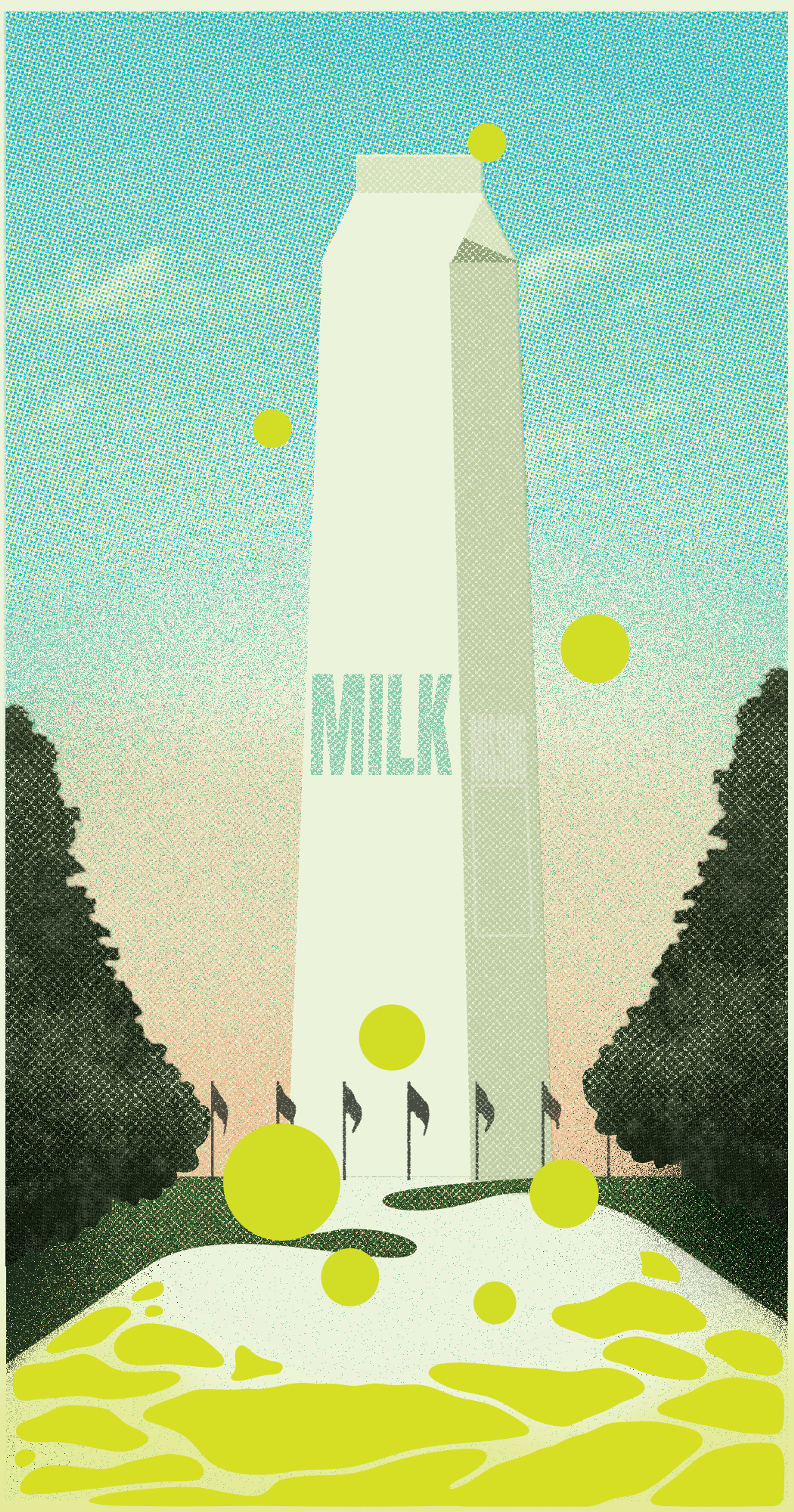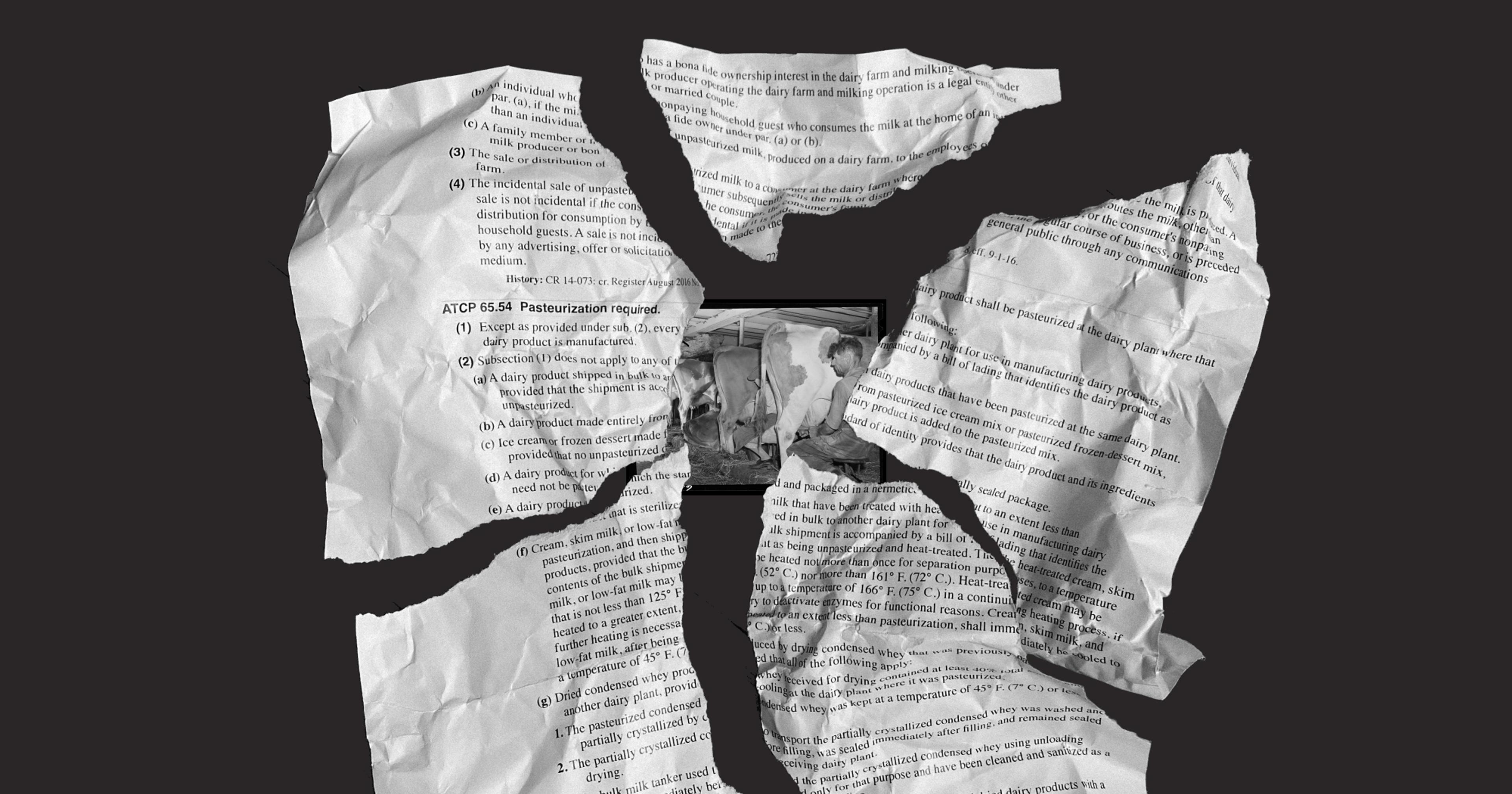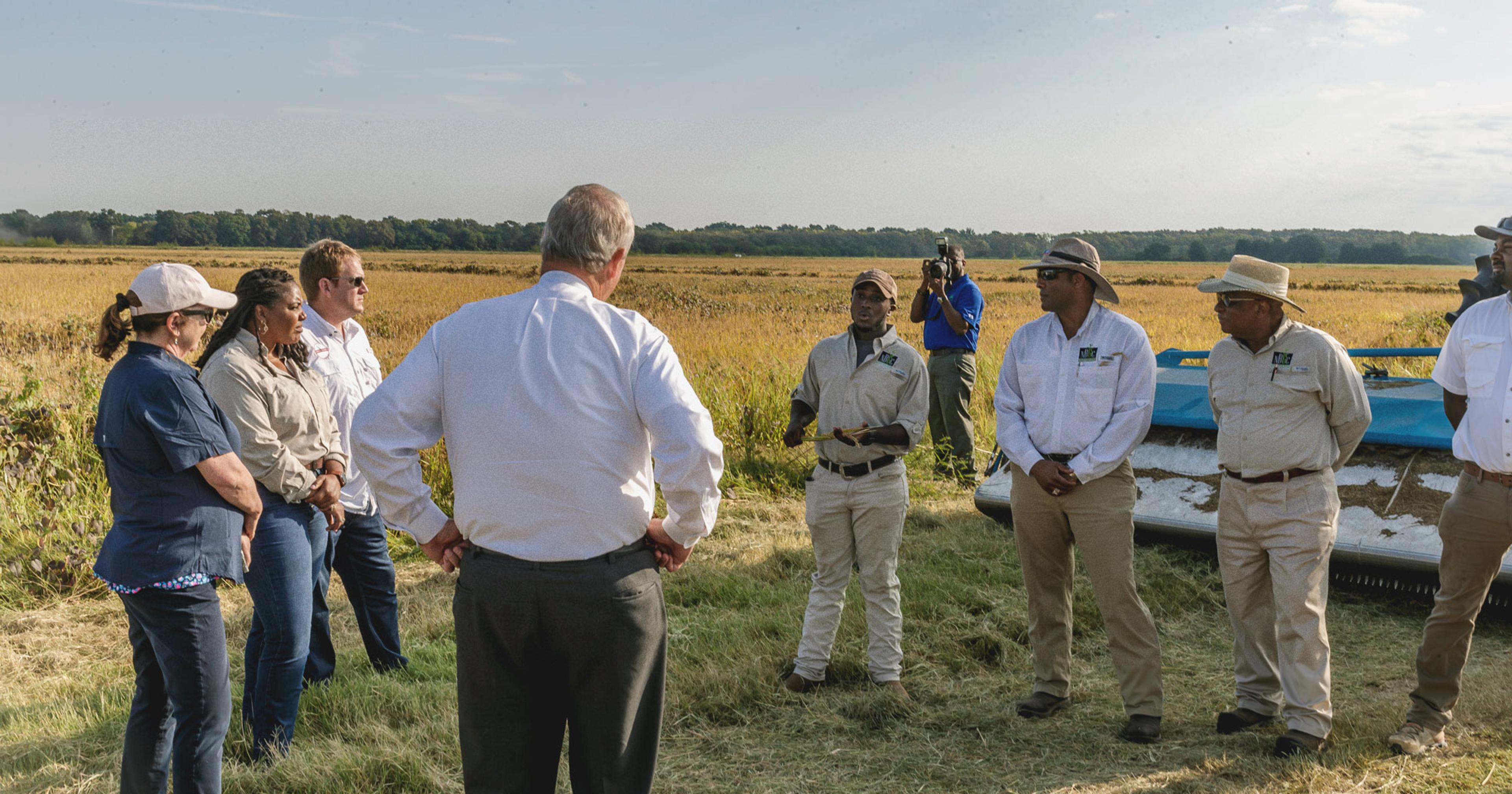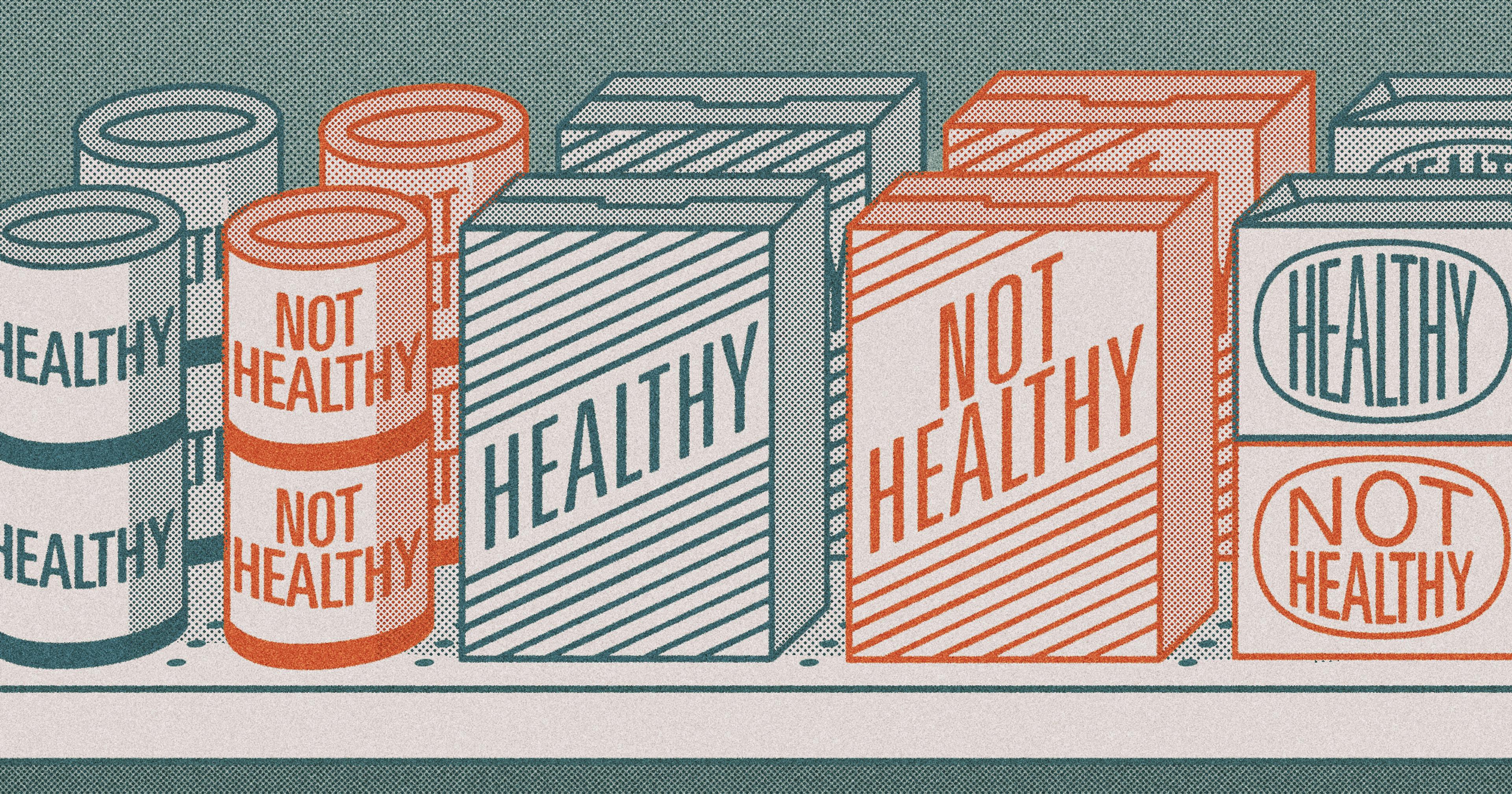Media panic about FDA’s suspended milk testing is exaggerated, but food safety advocates fear grave consequences as our oversight erodes.
Once upon a time, cow milk was a foul liquid, linked to fully one-quarter of all foodborne illnesses in the U.S. and in second place only to water for its ability to transmit disease. Epidemics of typhoid, tuberculosis, and scarlet fever were readily passed from milk to humans; additionally, an innocuous-looking glass of the stuff put a Gilded Age imbiber at risk of contracting salmonella, E. coli, campylobacteriosis, Staphylococcus aureus infection, yersiniosis, brucellosis, Q fever, and/or listeria. A century later, unpasteurized milk can still offer up a slew of historic hazards, as well as a new one — the H5N1 bird flu virus.
There’s one process that has so far reliably protected humans from getting sick from many of the pathogens that can fester in milk: pasteurization. It’s been standard practice since 1924, thanks to the efforts of the U.S. Public Health Service (the umbrella organization for the Department of Health and Human Services, which today oversees the Food and Drug Administration). Pasteurization is still keeping our milk supply safe as you read this — despite alarming headlines that appeared in the media at the end of this past April, like this one from the Greenville News: “FDA suspends dairy quality testing amid federal workforce cuts. Is it safe to drink milk?”
The short answer is yes — for now. But an ongoing erosion of trust in federal agencies meant to keep the public safe, as well as potential harmful consequences from kicking the safety can down the road in the middle of a massive bird flu epidemic, means there are reasons for concern.
The suspension of testing is happening at the FDA’s Moffett Center Proficiency Testing Laboratory in Chicago — mass layoffs mean there aren’t enough staffers to carry out the lab’s work. However, what this suspension practically means for milk safety got largely lost in the public freak-out. Way back when, the U.S. Public Health Service developed what’s known as the Pasteurized Milk Ordinance (PMO). This is a set of voluntary testing and other standards that counties and states could follow to ensure that the milk from their cows was safe to drink. The PMO exists to this day; it’s updated biennially and undergirds the milk testing that ensures a disease-free Grade A milk supply across the U.S.
“Program is currently paused but will resume once transferred to another FDA laboratory — an effort that is actively underway.“
After the Moffett news hit, the dairy industry rushed to assure Americans that there was no reason to forgo (pasteurized) milk: “Consumers can continue to trust that the dairy products they purchase at retail are safe to consume,” said a spokesperson for trade group International Dairy Foods Association in a statement. (IDFA declined to comment about the current milk-testing situation.) Consumer safety advocates largely agreed. But they’ve also cautioned that gaps in testing at Moffett — as well as an earlier announced suspension of testing for bird flu as that epidemic grows and morphs — could contribute to a less-safe food supply as waves of foodborne illnesses continue to crop up.
“I’m not sure there’s a direct threat to the food supply now” from milk, said Thomas Gremillion, director of food policy for the Consumer Federation of America, which is also part of a consortium called the Alliance for a Stronger FDA that seeks to keep the agency sufficiently funded. “Your milk is generally a pretty safe product if it’s pasteurized.” (Metal residues and pharmaceuticals are contaminants that heating can’t get rid of.) But the suspension of Moffett’s and bird flu testing are “part of a broader erosion of FDA’s capability to … detect outbreaks before they get big. It’s pretty scary,” he said.
Below, we take a look at what FDA downsizing actually does and does not mean for milk safety.
***
The 2023 update of the PMO is a 421-page behemoth that offers guidance to regulatory agencies — a state department of agriculture, for example — about keeping milk sanitary. This includes everything from how to construct and keep clean a milking barn; how to hygienically move milk from cow to hauling truck; how to sanitize equipment; how often facilities need to be inspected; and how frequently milk needs to be sampled from dairies and processing plants to make sure it meets various standards — usually once every three months.
Samples are sent for testing to a municipal or state lab. Washington’s lab, for example, tests over 3,500 samples a year, for aerobic and coliform bacteria, somatic (aka tissue) cells, antibiotics, and phosphatase (to check for proper pasteurization). Forty-six of 50 states have adopted these standards; states that haven’t adopted PMO standards have their own standards that are at least similar and in some cases might be higher. Some food retailers, like Costco, also do their own food safety audits. However, said Ilana Korchia, an attorney at foodborne illness law firm Marler Clark, the fact that not all state epidemiology labs are created equal is something to be uneasy about. “Without centralized federal oversight, there may be gaps,” she said.
The Moffett lab exists parallel to the PMO structure. Until April 2025 it conducted what’s called lab proficiency testing — basically, ensuring that 170 FDA-affiliated testing labs are capable of accurately and consistently identifying any contaminants sent to them in milk samples. This is the testing that’s been suspended. As an FDA spokesperson wrote in response to a comment request, the “Program is currently paused but will resume once transferred to another FDA laboratory — an effort that is actively underway. In the meantime, state and federal labs continue to analyze food samples, and FDA remains committed to working with states to protect the safety of the pasteurized milk supply.” Good news? Yes. With some caveats.
“It’s never good when you’re reducing instead of empowering these agencies, which were already understaffed.”
According to Gremillion, the suspension is effectively a gap in testing; this, he said, “undermines the federal government’s ability to surveil the food supply” and reduces our confidence that “public health authorities will be able to respond effectively if, say, the virus evolves to withstand pasteurization.” He said that under the Biden administration, there’d already been talk about closing the Moffett lab. It’s fine if FDA wants to consolidate lab functions or otherwise reorganize, “but they have gotten the cart before the horse here. I’m pretty sure the previous administration’s plans to close down the lab were not fire everyone and then figure out who can do the work somewhere else in the agency,” Gremillion said.
Korchia equates FDA’s role in keeping people safe to one essential leg in a three-legged stool, the other two being state and municipal oversight. “When someone falls ill, they get hospitalized. A [stool] sample returns positive for E. coli or [a blood sample for] salmonella or bird flu and if it’s a reportable disease in that state, the [hospital] reports that positive test result to the health department,” she explained. “Then it’s a coalition of state, county, and federal agencies that get involved and that do confirmatory testing and do trace back analysis. And it’s never good when you’re reducing instead of empowering these agencies, which were already understaffed.”
Gremillion concurs. “Some states have very robust public health and epidemiological surveillance infrastructure,” he said. “Minnesota has got state-of-the-art epi labs and they find more foodborne illness outbreaks — but they’re small. States like Alabama find fewer outbreaks — but they’re big. The takeaway is, if you don’t look for this stuff, you won’t find it.”
The Moffett lab is one piece of federal safety infrastructure that’s been cut. “It’s certainly not the only one,” Korchia said, pointing to the decimation of staff elsewhere at the FDA as well as at the Centers for Disease Control, which tracks outbreaks. She added, “I think this will continue to happen, and I don’t see it getting any better. Some people say, maybe this administration is cutting down these agencies in an effort to rebuild them, but we haven’t seen that yet.”
“The fact that new vectors of transmission are being identified now, when resources are being cut, is concerning.”
Gremillion points to another troubling outcome of the Moffett’s suspension: Its scientists were also working to “develop the capacity to test for H5N1, to ensure that we can respond if that becomes an important vector,” he said. In 2024, when bird flu re-emerged, the U.S. Department of Agriculture established the National Milk Testing Strategy (NMTS) to selectively monitor raw milk for the virus — which means there is “absolutely … a risk of further proliferation,” Korchia said. “Cattle that appear healthy can still harbor and transmit the virus asymptomatically.” FDA’s role was to sample dairy products — milk, cheese, and butter, for example — for any evidence that H5N1 had survived pasteurization (so far it hasn’t). This FDA testing has also been suspended.
Before the advent of avian influenza in the U.S., raw milk dairies had been expanding and regulations loosening. Bird flu, however, has been found in raw milk — a product that accounts for as much as 5 percent of the nation’s milk supply. New research indicates that raw cheese might also pose a bird flu infection risk. A new strain of bird flu has also evolved — B3.13, which has leaped from cows to cats, killing, sickening, or blinding a number of them. Said Korchia, “The fact that new vectors of transmission are being identified now, when resources are being cut, is concerning.”
Korchia noted that suspending milk testing is of a piece with a larger federal effort to abandon food safety measures; as of April 25, the administration walked back a proposal to test chicken for salmonella. “Each lab that gets shut down, each program that gets shut down, each federal employee that’s actively working on outbreak response and on testing and figuring out where the source of an outbreak is coming from that gets fired, is a step” towards “more chaos and less transparency,” she said.
“Have the first 10 days of the Trump administration done things that are causing foodborne illness out in the population?” asked Gremillion. “It’s really hard to know that, but moving forward, it seems like that’s going to be the ultimate effect.”










